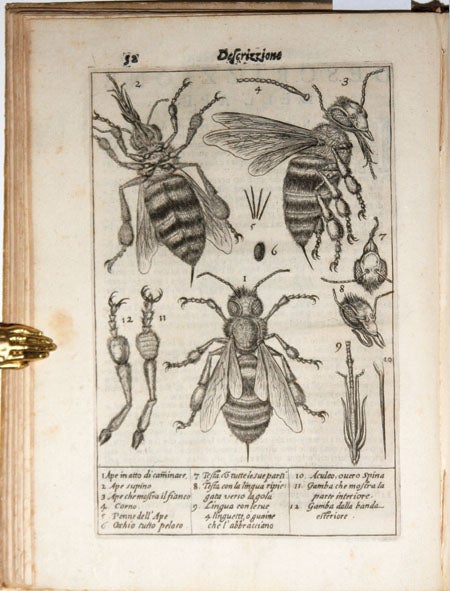
Persio tradotto in verso sciolto e dichiarato da Francesco Stelluti, Accademia Linceo da Fabbriano.
4to.,[21 x 15.25 cm], (12) ff., including allegorical engraved frontispiece with Barberini arms and the emblem of the Lynceans, signed Matthias Greuter, and one unsigned engraved portrait of the Latin poet Persius, 218 pp., including one full page engraving of a bee as seen under microscopic enlargement, and 5 quarter page engravings in text, (10) ff., 1 blank. Bound in contemporary flexible vellum, title stenciled in gothic lettering on spine. Some foxing and light browning, generally uniform, but less severe than often seen in this work. Generally a fresh, unsophisticated copy, very good.
First edition of this illustrated Italian translation of the Roman poet Persius (CE 34-62) by Galileo’s correspondent, friend, and fellow member of the Accademia Linceo, containing “the first illustrations prepared with a microscope that were set forth in a printed book” (Singer p. 148), including the anatomical ‘bee’ engraving made possible with Galileo’s microscope. Stelluti’s work also makes frequent mention of the ongoing work of the Linceo, including notes on Galileo’s observations of Jupiter and Venus, as well as his recent work-in-progress: the 1632 Dialogue.
As Freedberg (The Eye of the Lynx) observes, the work’s real significance lies in its footnotes, which frequently digress to remark on the Linceo’s canon of scientific achievements: “By far the most important notes to this satire are those in which Galileo appears… summarizing Galileo’s major discoveries and recalling Galileo’s meetings with Cesi and other Linceans to scan the heavens. Finally Stelluti alludes to the forthcoming appearance of the Dialogue on the Two Chief World Systems, the work that would finally send Galileo to the Inquisition” (Freedberg pp. 187-8).
Of the work’s 12 copperplate engravings, the most significant is that of the Barberini trigon of bees, engraved in microscopic detail via Galileo’s own instrument. A similar image had appeared on the 1625 broadsheet engraving Melissographia—“the first microscopic observations to be published” (DSB)—dedicated by the Linceo to the Barberini pope Urban VIII; yet the present engraving, in addition to adding an anatomical legend below the illustration, is also accompanied by 2 ½ pages of original explanatory text. This plate, and a similarly detailed illustration of a weevil, constitute “the first illustrations prepared with a microscope that were set forth in a printed book.” (Singer, p. 148).
Francesco Stelluti (1577-1662) was one of the three founding members (with Cesi and Johannes Eck) of the Accademia Linceo, and among the circle of luminaries who worked most closely with Galileo. In addition to his frequent correspondence with Galileo, Stelluti contributed dedicatory poems to the preliminaries of both the Letters on the Sunspots (1613) and the Assayer (1623).
* Cinti 86; DSB.XIII, pp. 29-30; Freedberg, The Eye of the Lynx; pp. 161-194; Singer, History of Biology, p. 148.
Sold
